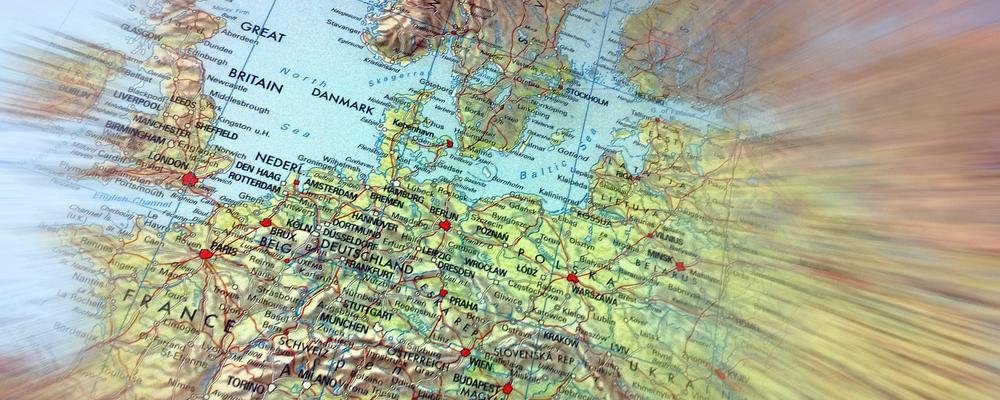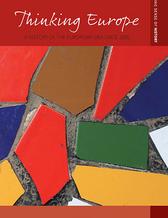
- Home
- News and events
- Find news
- 200 years of ideas around a united Europe
200 years of ideas around a united Europe
How have the ideas about a united Europe gone hand in hand – or clashed – with ideas about the distinctive character and borders of nations within Europe over the last two hundred years? The book Thinking Europe explores the conceptual framework for European integration from 1800 to the present, and provides a framework for understanding the fundamental issues facing Europe today.
Mats Andrén’s book Thinking Europe: A History of the European Idea Since 1800 is aimed at researchers and students pursuing studies in history or European studies, and anyone who is interested in Europe and questions about Europe. It establishes a historical context for the ideas that have led to contemporary usage of the idea of Europe.
“It is a history of how Europe has been conceived as an idea. A history of Europe as a political idea, but also as a cultural concept that extends beyond cultural boundaries, such as between Catholicism and Protestantism or different languages. It is a story of what ideas about a European identity have looked like,” says Mats Andrén, who is a professor of History of Ideas at the University of Gothenburg.
Cultural identities

Within the EU, European integration has primarily been economic, legal and political. However, for the past few decades, the EU has also endeavoured to promote a shared identity through symbolic elements, the establishment of a European citizenship, and attempts to define a European culture and identity.
“At the same time, the importance of these shifting cultural identities is increasing within Europe. The paradox is that while progress is being made with economic and legal integration, the element of cultural boundaries is increasing. Historically, the ideas of Europe and nationhood have developed alongside each other.”
Andrén’s book examines how ideas about community building have spread between the countries of Europe.
“France, Germany and England are often regarded as role models. It is to them that countries such as Sweden, Spain and the Czech Republic often turn for ideas on how their countries should develop.
Broader perspective
Through its broader perspective, Thinking Europe differs from previous works on the subject – it studies not only France and Germany, but also other parts of Europe. It offers a transnational perspective. It deals with ideas about Europe put forward by politicians and political writers, by philosophers and academics, and by writers of fiction and other intellectuals. The book also stands out in that its starting point is the years around 1800.
“Other books start from either one or two millennia earlier. Or they begin from the formation of the EU and omit the crucial 1800s, the world wars and the inter-war period. But the idea of a united Europe is much more than a reaction to Hitler and Nazism. I begin at the year 1800 precisely because something new started right then.
Thinking Europe is divided into three parts. The first theme deals with unification and borders, the second with crisis and decline, and the final section deals with integration and identity.
Thoughts on unification
Although ideas about a unified Europe have been around for a long time, they experienced an upswing and a different kind of spread and were leveraged differently in the early 1800s.
“By closely tracking the term Europe, it becomes clear that as of this point, it was linked to liberalism as well as conservatism and socialism, and with fundamental concepts such as civilisation, individualism and development.”
During this period of European history, many other ideas about borders also flourished. The uniqueness of nations was emphasised in particular, and also ideas about specific regions, such as Central Europe, Southern Europe, Eastern Europe, etc.
Wars and crises
Wars and crises have impacted ideas about a united Europe in one way or another.
“Especially from the First World War onwards, when there were widespread ideas about a loss of values. Economically, Europe was being challenged by the USA and was deeply in debt. At that time, the numerous borders between European states were considered to be a key cause of the crises.”
It was also during the 1920s that a long list of transnational organisations were established that had as part of their agendas an aim to work towards an economically, politically and culturally united Europe.
“The answer to crises was that Europe must be united. The idea was that a united Europe would better withstand various acute threats and long-term challenges. This way of thinking has been carried forth into our present day – that European crises are best solved by strengthening cooperation.”
A European identity
Following the Second World War, the terms European integration and a European identity took centre stage. Talk about economic integration, which Mats Andrén traces back to the 1930s, was taken up in the late 1940s as a means of pleading for European cooperation and for the independence of nation states.
From the 1970s onwards, ideas about a European identity began to emerge.
“They could be seen in both narrower political debate and debates among intellectuals. The fundamental idea was that the development of a European identity would strengthen the European Community. If we, as Europeans, felt that we belonged together, the EU would also have greater legitimacy among the Member States’ populations.”
Turbulence in recent years

Mats Andrén has been working on the book since 2013 and over the years, a string of events have given him reason to rethink its closing chapter more than once – everything from the global pandemic to the financial crisis, Brexit, the migration crisis and the war in Ukraine.
“Researching and writing about Europe is fascinating. As a historian of ideas, when you navigate past eras, the story is already over. However, when it comes to questions about European, there is always something happening that has an impact on how you think, and which injects some energy into what you intend to write.”
Andrén’s work on the book and the events of recent years have made him realise that ideas about European integration are not hurt by crises. He believes that the current situation, where 27 countries are bound together in a union that more countries would like to join, will stand firm.
“European cooperation is taking up ever more time for these countries, even when it does not involve their agreement on how everything should look. There is a more robust discussion about what this Europe should be in terms of values and European policies. This does not mean that we have fewer tensions within the EU, but that the framework is quite stable at the moment,” says Andrén.
Thinking Europe: A History of the European Idea since 1800 is published by Berghahn Books and is available as open access: https://doi.org/10.3167/9781800735699
Contact details:
Mats Andrén, phone: +46 (0)31-786 4476, email: mats.andren@lir.gu.se

